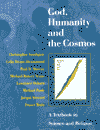Peacocke’s View of Divine Action
The best way to compare theories of divine
action in detail is to ask - what, for each theory, is ‘the causal joint’ at
which God - as a transcendent, immaterial world cause - interacts particularly
with causative factors in the material world?
Arthur Peacocke wants to use the analogy of
God as mind, world as body, but with a very proper caution - ‘in a human body,
the “I” does not transcend the body ontologically in the way that God
transcends the world.’ He is also very cautious about explicating the causal joint - such a
description of the problem ‘does not do justice to the many levels in which
causality operates in a world of complex systems interlocking in many ways at
many levels.’ He is also very cautious about explicating the causal joint - such a
description of the problem ‘does not do justice to the many levels in which
causality operates in a world of complex systems interlocking in many ways at
many levels.’ He does not find any theologically-relevant
gaps in the causal order, and is temperamentally most reluctant to contemplate
anything smacking of divine intervention
in the natural order (see the question of miracle). He does not find any theologically-relevant
gaps in the causal order, and is temperamentally most reluctant to contemplate
anything smacking of divine intervention
in the natural order (see the question of miracle).
So Peacocke follows Kaufman and Wiles in postulating that God’s action is on the-world-as-a-whole, but he goes
further than either in that: in postulating that God’s action is on the-world-as-a-whole, but he goes
further than either in that:
-
he offers a metaphor for divine action
in terms of the way in which the properties of a whole system, such as a
chemical system far from equilibrium, or a biological ecosystem, affect the
behaviour of individual parts. The nature of the whole, and its environment,
exerts constraints on the behaviour of the parts. This he originally called
‘top-down causation’ but now prefers to call ‘whole-part influence.’ The material world, on this model, has God as its boundary or environment;
relationship with God is the highest emergent property of any physical system. The material world, on this model, has God as its boundary or environment;
relationship with God is the highest emergent property of any physical system.
-
Peacocke allows the possibility that
this general action of God’s on the-world-as-whole might have particular
effects - just as a boundary constraint in one of the systems described above
might generate a particular, localised pattern.
Peacocke’s God, then, is the environment of
the cosmos. His God’s
interaction with the world, by means of the input of information - is the
highest-level emergent property (see the concept of emergence) of the cosmos as
system, a system within which God is radically and totally immanent, as well as
transcendent. His God’s
interaction with the world, by means of the input of information - is the
highest-level emergent property (see the concept of emergence) of the cosmos as
system, a system within which God is radically and totally immanent, as well as
transcendent.
As Willem B Drees points out, speaking of the environment of the whole universe can never be more than a
metaphor, but it is the strength of panentheism that it can offer such a telling
metaphor. Thomas Tracy also takes Peacocke to task for stretching a concept too
far - he points out that the examples of ‘top-down’ causation we know about are
all analysable in ‘bottom-up’ terms. speaking of the environment of the whole universe can never be more than a
metaphor, but it is the strength of panentheism that it can offer such a telling
metaphor. Thomas Tracy also takes Peacocke to task for stretching a concept too
far - he points out that the examples of ‘top-down’ causation we know about are
all analysable in ‘bottom-up’ terms. Top-down causation is a purely explanatory procedure, it is a bold strategy to
invoke it for ontological purposes, and to suppose that a ‘whole’ can be
invoked as an actual cause within a system. Top-down causation is a purely explanatory procedure, it is a bold strategy to
invoke it for ontological purposes, and to suppose that a ‘whole’ can be
invoked as an actual cause within a system.
To examine these views in detail see Peacocke and Polkinghorne compared.
Email
link | Feedback | Contributed by: Dr.
Christopher Southgate
Source: God, Humanity and the
Cosmos (T&T Clark, 1999)
|




